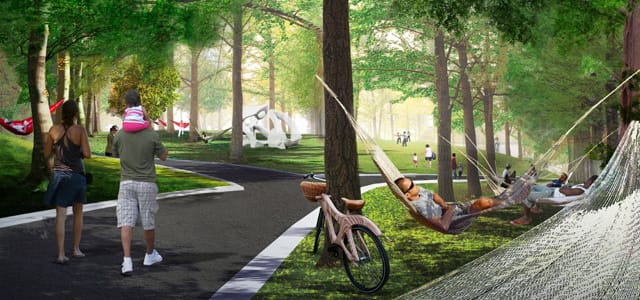A playground for kids to explore and parents to grow.

New York City’s Governors’ Island has become a slate for designing the park that revolutionizes the collective concept of playgrounds and parks. For many decades the design psychology has been one of paranoia and protection, as we explored in Yannick Lejacq’s history and future of New York City playgrounds and our Public Play issue. The New Yorker reports that over on the island, architects are taking after the egalitarian play of Europe’s parks, spaces whose virtues of design disarm its visitors and protect by way of play.
“People spend several hours here” on the weekends, says Leslie Koch, president of the Trust for Governors Island. Free ferries from Manhattan and Brooklyn bring visitors in for extended afternoons. “You wander through the island, you have an idea or you may not, the kids run around. There aren’t precedents for that kind of place. It’s different than a beach or an urban park, or even a state park, where you go to barbecue.” She adds, “Early on we said we didn’t want to have playgrounds, but we didn’t say what that meant.” It was up to the Dutch landscape architects West 8, led by principal Adriaan Geuze, to create that meaning.
…
“If you create a park-like environment and people feel really free, adults hang out and participate like children do,” Geuze says.
The Dutch architects designing Liggett Terrace wish to liberate you by turning the land into an extension of nature instead of a curtailment of it.
The new Hammock Grove Play Area south of Liggett Terrace will combine elements of sculpture and adventure: two heights of log-climbing structures that look like pick-up sticks for giants, a pyramid-shaped climbing net, and nest and hammock swings big enough for adults and groups. Log benches are placed right under the nets and trunks for those who want to watch. Nappers can head out into the real trees and lie in a hammock.
…
“We live in very commercial world where everything is a product, is a brand, is a color, is a logo,” Geuze says. “A park should not be part of that logic. It should be neutral and bleed into the forest.” There will also be stroller parking and bike racks, so that people “are not having stress. If there’s no place to put a stroller, no place to sit, that’s not what play is about.”
The wonder of Governors Island as it is now, and the dream of the landscape design for the future, is of a place in the city where no one in the family has to worry, to hover, to schedule. In this park, will we finally be able to stop helicopter parenting ourselves?
See that we may. The designers want us to look at parks and playgrounds as places that bury boundaries, not erect them—places where we forget for a moment the scheme of the city for the solace of nature.



